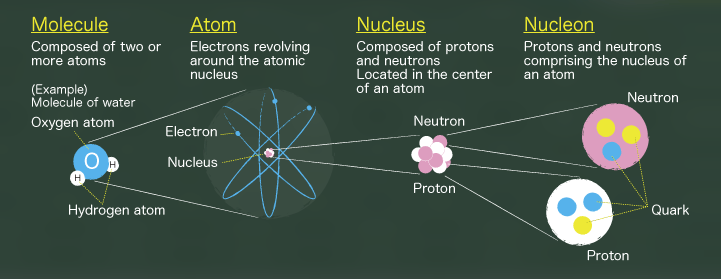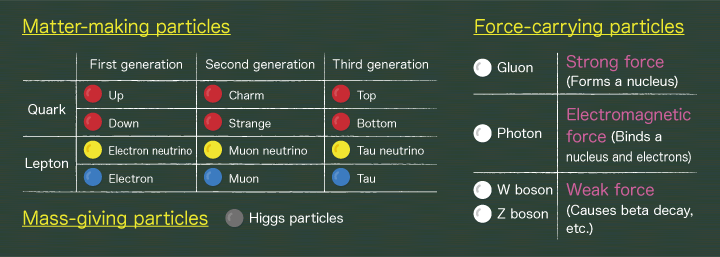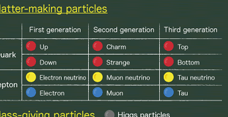 Home > Photon lab. > “The Story of Particle Physics” by Mr. Ohsuka > Intro to “The Story of Particle Physics”
Home > Photon lab. > “The Story of Particle Physics” by Mr. Ohsuka > Intro to “The Story of Particle Physics”
Intro to “The Story of Particle Physics”
<1>
Intro to “The Story of Particle Physics”

- Written by
-
Shinji OHSUKACentral Research Laboratory, Hamamatsu Photonics K.K.
Specialized field : Light measurement(photon counting), Radiation measurement, Mathematical statistics.
The path we have traveled starting from the question “What is matter?”


What makes up matter in the natural world including us and what is matter comprised of? In the early 19th century, John Dalton and Amedeo Avogadro and others proposed the existence of atoms and molecules as the basic units that make up all matter. After that, great discoveries have been made one after another. For example, Joseph John Thompson discovered the electron in 1897, Ernest Rutherford discovered the nucleus of the atom in 1911, James Chadwick discovered the neutron in 1932, and more recently the Higgs boson was discovered in 2013 by experiments using the Large Hadron Collider (LHC) built by the European Organization for Nuclear Research known as CERN. In this way, we human beings have gained a deeper understanding to the question “What is matter” and now the Standard Model of modern particle physics gives us the following picture as an answer to this question:
All matter is composed of fundamental particles called quarks and leptons. The fundamental forces (interactions) between those particles, such as the electromagnetic force, the weak force, and the strong force, are mediated by exchanging force-carrying particles, and some particles acquire mass by the so-called the Higgs mechanism.

The Standard Model lists the fundamental matter-making particles and the force-carrying particles, and describes the interactions between them. It is a theory reached after accumulating numerous research results obtained through both theoretical and experimental studies made by many physicists. You might say it represents the core of the wisdom of the mankind.
Relation between particle physics and light

By the way, what is the role of the elementary particle of light called the photon in particle physics? As shown in the above figure, according to the Standard Model of particle physics, photons are one type of the force-carrying particles and mediate the electromagnetic force acting between elementary particles. The electromagnetic force binds negatively charged electrons to the positively charged nucleus of an atom. Therefore photons play an important role in making up all matter including the matter in our bodies.
I have been working for more than 30 years in both basic research and applied research on light or photons. I am delighted that photonics technology for photomultiplier tubes, semiconductor photodetectors and other devices we have developed has been used for research carried out at experimental facilities such as Super-Kamiokande in Japan and the Large Hadron Collider (LHC) in Europe that help broaden the horizon of mankind’s knowledge. I’m excited to see the coming of this age of science that makes us feel that we are approaching the answer to the fundamental question “What is matter?” Through this “The Story of Particle Physics” series, I would like to show, a little at a time and in my own way, part of the answer to the question “What is matter?” which has been discovered or is gradually being discovered by particle physics.
See the other articles in this category.






